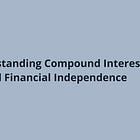Make sure you’ve watched my first lecture—“Understanding Compound Interest and Financial Independence”—to see how value investing leads to exceptional returns. It lays the foundation for everything we’ll cover here.
Welcome to my second lecture: “All You Need To Know About Value Investing – How To Beat the Market While Taking Less Risk.” In it, I will cover:
The fundamental principle of value investing: why a good asset isn’t always a good investment
How to spot undervalued opportunities—whether in stocks, real estate, or elsewhere—by estimating intrinsic value
Why price and value diverge, and how disciplined investors can take advantage
The only kind of risk that really matters—and how to protect yourself with Margin of Safety and your Circle of Competence
A Q&A section answering the most common questions and misconceptions about value investing:
What return can a good value investor expect?
What about growth stocks? Haven’t they outperformed value stocks over the last years?
What about real estate?
How can my intrinsic value estimate be more accurate than the market price?
How do I know that the price will eventually match my valuation?
How many stocks should I own in my portfolio? What about diversification?
How long should I hold a stock for?
How do I start?
If the current market turbulence has you feeling uneasy, this might be a good time to go back to the basics. Let me know, if you have any more questions!
Script
You can find the “slides” here. Thank you for the video!
Intro
Welcome to my second lecture: “All You Need To Know About Value Investing – How To Beat the Market While Taking Less Risk.”
Today, I’ll cover the most important principle in value investing and answer common questions.
⇒ Explain Buffett & Munger origin
Let’s get into it.
Core principle: There’s a difference between a good asset and a good investment.
Good assets are easy to identify:
Companies with a competitive advantage that generate strong profits
Market leaders in growing industries
Prime real estate in top locations
But buying them doesn’t guarantee a good return:
That’s because everyone knows these assets are good. And that is reflected in their price.
A good investment means buying something for less than it’s worth:
Rarely, you’ll find great assets at great prices—usually in a crash.
Sometimes you’ll find great assets at fair prices.
Most often, you’ll find average assets at great prices.
The type of asset doesn’t matter—stocks, bonds, real estate, private businesses...
What matters is whether you can estimate its true value with enough certainty.
If you don’t know if you are able to do that, you are not. And you shouldn’t make any investment decisions yet!
You can either put your money in an index ETF and achieve the average market return - or learn how to value assets to find investment opportunities that outperform the market
It’s not complex—but it does take time and effort.
So I believe you should only try if you think that learning about businesses or other assets is fun and rewarding beyond the potential to make you rich.
So, how do you estimate the actual value (generally called “intrinsic value”) of an asset?
It’s not the price
The intrinsic value of any asset is the cash it will generate over its entire life, discounted to reflect the time value of money.
Example: A machine that prints $10 a year for 5 years is worth about $50 (discounted to today).
Most assets like stocks or real estate have a very long lifetime and nobody is able to predict the cashflows for each year in the future with accuracy.
And the more you try, the higher the risk of being “precisely wrong, instead of roughly right”.
I will show you a better way in the next lecture “Basics of Business valuation”. For now, trust me that there are assets out there, that you will be able to value with a high degree of certainty.
If an asset is available at a price that is much lower than your intrinsic value estimate, it is a great investment. If the price is higher than the value, it will not be a good investment.
It doesn’t matter if the stock just doubled or crashed.
It doesn’t matter if it’s a growing or shrinking industry
It doesn’t matter if it looks cheap or expensive compared to peers.
The only thing that matters is that the price is significantly lower than the intrinsic value!
This is the fundamental principle of value investing:
Assets have a true value that often differs from the market price.
If your estimate is solid and you can buy well below that, you’ve found a good investment.
You don’t need to know much more about value investing. And we could start with our first business valuation.
But your uncle, neighbor or financial advisor will have seemingly valid objections and I want to make sure you’re not discouraged easily, so let me explain some more concepts and answer frequently asked questions about value investing.
What return can a good value investor expect?
It’s a lot of effort so in my view, a good value investor beats the market by 5 to 10 ppt per year on average.
That would have been around 20% per year over the last years, but it’s unlikely this market performance will continue, so 15% is a good goal in my view - and it’s very hard to do over a long time
But if you constantly invest in assets that cost 50% of what their worth, it’s definitely possible
What about growth stocks? Haven’t they outperformed value stocks over the last years?
This distinction is not helpful.
Growth is a part of value. It can add value or destroy value depending on the required capital to achieve that growth.
Give example
Value investors love businesses that grow like crazy without requiring more capital. Call them growth stocks if you like. If they are able to understand the company well, they will go all in.
What about real estate?
Many people think stocks are risky and real estate is a safe way to get rich.
So they avoid stocks but have no problem taking a huge loan to buy property
This bias is very costly - and absolutely crazy.
The true risk of any investment depends on the gap between price and value—not the asset class.
There are low-risk stocks and high-risk real estate deals.
The right way to think about it is: What are the opportunities within my circle of competence?
⇒ All the assets you can value with high certainty. Then you take the best ones. No matter if it’s a stock, a bond, real estate - or even a university degree or a public speaking class…
If the returns these opportunities offer are not enough for you, you can decide to use leverage. Leverage amplifies returns, but it increases risk: 50% leverage means that losing 50% of your investment will wipe you out completely. If it’s worth taking that risk depends on your personality and on the quality of the investment opportunity - not on the asset class!
Over time, price and value converge. If you overpay, you’ll likely lose money—with stocks or real estate.
And with leverage, the losses are bigger.
The idea that you should be afraid of stocks but can sleep well with highly leveraged real estate investments does not make sense!
How can my intrinsic value estimate be more accurate than the market price?
Many academics have claimed for a long time that it can’t, because all the information about a company is already reflected in the price. That is called the efficient market hypothesis
That’s often true, but certainly not always. Consider this
The economy (GDP) doesn’t move much.
Companies earnings move a little more
Stock prices move a lot more ⇒ that’s not reflective of true changes in value
Ben Graham: Mr. Market
Crazy neighbor who yells prices for your property over the fence every five minutes. You can buy, sell, or do nothing
Most of the time what he yells will be close to the actual value, but sometimes it’s off completely. Then you act.
You can never be sure that your intrinsic value estimate is more accurate than the market price - so there are some safety mechanisms to protect you:
Margin of Safety: If your estimate comes out at $1 million, you don’t buy for more than $600k
Asymmetric bets
Heads I win, tails I don’t lose much ⇒ downside protection
Circle of Competence
How do I know that the price will eventually match my valuation?
You can’t, but it doesn’t matter - as long as the management is shareholder-minded
Example: A company generates €1 million in earnings and is only valued at €5 million. You think it’s worth €10 million so you invest. The valuation (stock price) never increases.
BUT: You will earn 20% on your equity every year! A shareholder friendly management will return that cash to you - in this scenario hopefully through share buybacks, but a dividend would be fine too. Maybe they even find ways to retain these earnings, invest them in the business and generate more earnings in the future.
How many stocks should I own in my portfolio? What about diversification?
Many rich people have their net worth in one stock: The company they started.
And think of all the private businesses. Are their owners worried about diversification? Would they prefer to give away 95% of their company so they can spread their capital among 20 companies instead of one?
If you really know a company well and know what you do, I don’t see a problem with the idea of owning just one stock
But if you are analyzing companies from scratch, you will find multiple investment opportunities with similar risk-reward profiles. So you might prefer to allocate the same amount to each of these opportunities.
In that case, I recommend to not hold more than 10 positions at the same time. As long as you are very confident that you bought them for 50% of what they are worth, 10 companies is enough diversification. And it’s a lot easier to find 10 undervalued companies than to find 30.
A portfolio of 10 stocks or less will fluctuate a lot. It will be very volatile. And some people will tell you it is therefore very risky. That is a weird definition of risk. If the value stays the same, how can the crazy neighbor that shouts prices over the fence increase risk? You don’t have to act!
The only right definition of risk is the common sense one: Likelihood of permanently losing capital. And I believe that likelihood is low if you spread your capital among 10 companies that you have studied intensely and understood well (and found to be undervalued).
How long should I hold a stock for?
Great companies forever
Average companies that are undervalued - until they reach your estimated valuation
But: I recommend a minimum holding period of one year. Value investors are conservative. They often estimate intrinsic values too low. So if the company reaches your estimate after 6 months, just wait a little longer and see what happens
How do I start?
By reading about Buffett & Munger! I have summarized the most important resources here:
And my favorite books on investing here:






